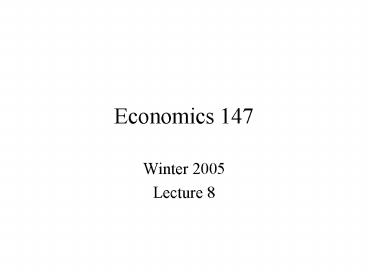Economics 147 - PowerPoint PPT Presentation
1 / 24
Title:
Economics 147
Description:
The Tiebout model and traditional school choice. How it fits into the course ... Assume a head tax (same level of tax for everyone) Assume a property tax based ... – PowerPoint PPT presentation
Number of Views:105
Avg rating:3.0/5.0
Title: Economics 147
1
Economics 147
- Winter 2005
- Lecture 8
2
Outline for today
- The Tiebout model and traditional school choice
- How it fits into the course
- Arguments for and against centralization of
education - The model
- Assumptions
- Policy implications
3
Where are we in the course?
- Started with human capital investment problem
- Expand it to allow possible return to schooling
from signaling - Allow school quality to matter in determining
return to education - Education production functions
- Public vs. private
- Class size, peers
4
Theme throughout
- Must identify causal effects of schooling (or
particular quality component) - Remember that people choose quantity/quality of
schooling - These choices may be influenced by omitted
variables
5
Economic framework
- Optimal investment decision demand for
education - Education production function supply of
education - Next markets for education
6
What level of government should provide education?
- Why should government provide education at all?
- Credit market failures
- Externalities
- Given government provision, how centralized
should it be? - Most centralized ? most
decentralized - Federal ? State ? County ?
Community
7
(No Transcript)
8
Unfunded mandates
- Do not show up in intergovernmental revenues and
expenditures - 1970s federal deficit ? federal govt passed on
responsibilities to the states - Late 1980s, states entered fiscal crises, passed
on responsibilities to localities
9
Arguments for centralized provision of government
services
- Efficiency arguments
- Economies of scale
- Spillovers across jurisdictions
- Equity arguments
- Greater capacity to redistribute
10
Arguments against centralized provision of
government services
- Efficiency arguments
- Match individual preferences more closely
- Promote competition in provision of the good
- Matters if you are worried about bureaucrats
trying to maximize their budgets - Diseconomies of scale
- Equity arguments
- Hard to make
11
Tiebout (1956) model of local provision
- Starting point people understate their
preferences for government spending (G) if they
will be taxed accordingly (free-rider problem) - Tiebouts insight dont ask people how much G
want, make them reveal it through where they
choose to live - Different communities offer different levels of G
and different tax rates - Individuals vote with their feet
- Eliminates ability to free ride ? improves
efficiency
12
Tiebout hypothesis
- Public goods provision will be efficient at the
local level (under many assumptions)
13
Model
- Many individuals divide themselves into different
local jurisdictions (towns) - Each town has N residents
- Private good x (px1)
- Public good G (pG1)
- Within a town, residents are identical
- Indiv preferences given by U(x,G)
- Indiv budget constraint
- x G/N y
14
Tiebout makes strong assumptions
- Need a competitive market
- Consumers are fully mobile
- no moving costs
- Consumers are fully informed
- perfect information on govt services and taxes
- Unlimited number of communities exist
- at least as many as types of people
15
Assumptions about production function
- No externalities or spillovers across communities
- Positive externalities make local residents
supply G at an inefficiently low level - Negative externalities (like pollution) make
local residents supply G at an inefficiently high
level - Constant marginal costs
16
Assumptions about financing
- Need these assumptions to prevent free riding
- Must do one of these
- Assume a head tax (same level of tax for
everyone) - Assume a property tax based on home value and
assume zoning
17
Are competitive market assumptions realistic?
- Consumers are fully mobile
- US Census 16 of Americans have a different
address in a given year than they did the year
before - Moving costs have declined over time but are
still sizable, especially non-monetary costs - Consumers have perfect information on govt
services and taxes - Blinder Krueger evidence on federal level next
- At least as many communities as types of
individuals - Varies by metropolitan area
- One school district per 36,025 people in CA
- One school district per 14,302 people in NJ
- One school district per 254,016 people in FL
18
(No Transcript)
19
Source Blinder Krueger
20
Are production function assumptions realistic?
- No externalities or spillovers across communities
- Low level of environmental regulation/enforcement
in Mexico affects Imperial Beach (CA) water
quality - State-subsidized UC education benefits other
states - Constant marginal costs
- Depends on the good being provided
21
Are financing assumptions realistic?
- Must do one of these
- Assume a head tax (same level of tax for
everyone) - - unrealistic
- Assume a property tax based on home value and
assume zoning - - we see this in reality
22
Why zoning?
- Property tax is applied to the value of the house
- You can free ride by buying a small house in a
rich neighborhood - You benefit from your neighbors high tax
payments on fancy houses but pay little yourself - Rich want to keep the poor out of their
neighborhoods to prevent this free riding - Zoning is a way to do this
23
Example Lincoln, MA original zoning law
24
Characteristics of (our stylized) equilibrium
- HHs set MB of school quality MC
- Households sort themselves into communities by
preference for school quality - House prices capitalize differences in school
quality - Producers of schooling produce efficiently

